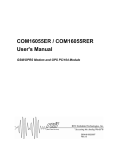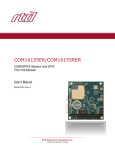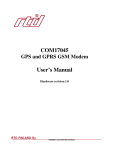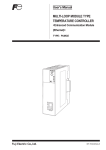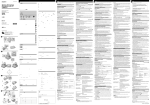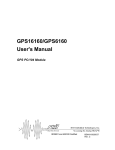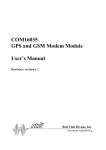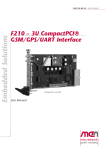Download Siemens MC55 User`s manual
Transcript
GPRS6055ER / GPRS6055RER User's Manual GSM//GPRS Modem PC/104 Module BDM-610020058 Rev. A GPRS6055ER / GPRS6055RER User's Manual RTD EMBEDDED TECHNOLOGIES, INC. 103 Innovation Blvd State College, PA 16803-0906 Phone: +1-814-234-8087 FAX: +1-814-234-5218 E-mail [email protected] [email protected] Web Site http://www.rtd.com Page 2 of 31 Manual Revision History Rev A New manual Published by: RTD Embedded Technologies, Inc. 103 Innovation Boulevard State College, PA 16803 Copyright 2006 by RTD Embedded Technologies, Inc. All rights reserved The RTD Embedded Technologies Logo is a registered trademark of RTD Embedded Technologies. dspModule, cpuModule, and utilityModule are trademarks of RTD Embedded Technologies. PC/104, PC/104, and PCI-104 are registered trademarks of the PC/104 Consortium. All other trademarks appearing in this document are the property of their respective owners. Page 3 of 31 Table of Contents Introduction ...................................................................................................................................... 6 Product Overview......................................................................................................................... 6 Board Features ............................................................................................................................ 6 GPRS6055ER Features ....................................................................................................... 6 GSM Receiver ...................................................................................................................... 6 I/O Interfaces................................................................................................................................ 6 16C550 Compatible UART ................................................................................................... 6 Connector Description .......................................................................................................... 7 Available Options ......................................................................................................................... 7 Getting Technical Support ........................................................................................................... 8 Board Connections .......................................................................................................................... 9 Connector and Jumper Locations................................................................................................ 9 External I/O Connections ............................................................................................................. 9 CN7 – Digital Input/Output Connector.................................................................................... 10 CN6 – SIM Module/Connector ............................................................................................... 11 CN7 – GSM Headset Connector ............................................................................................ 12 Jumpers ..................................................................................................................................... 13 LED Indicators............................................................................................................................ 13 Board Installation ........................................................................................................................... 14 Installing the Hardware .............................................................................................................. 14 Static Precautions .................................................................................................................. 14 Steps for Installing.................................................................................................................. 14 Configuring Software ................................................................................................................. 14 Hardware Description .................................................................................................................... 15 Overview .................................................................................................................................... 15 Block Diagram............................................................................................................................ 15 The GPRS GSM wireless modem module ................................................................................ 16 GPRS/GSM wireless modem module interfaces ................................................................... 16 GSM Antenna considerations................................................................................................. 16 Page 4 of 31 SIM-card reader ..................................................................................................................... 17 GPRS6055ER Digital I/O ........................................................................................................... 17 Interrupts .................................................................................................................................... 17 GPRS6055 Module Programming ................................................................................................. 19 Defining the Memory Map.......................................................................................................... 19 Digital I/O ................................................................................................................................... 19 Digital I/O – R/W at BASE + 400h.......................................................................................... 19 Advanced Digital I/O – R/W at GSM BASE + 400h ............................................................... 19 GSM I/O Space .......................................................................................................................... 19 GSM I/O UART (GSM BASE + 0 to GSM BASE + 7) ............................................................ 19 GSM Status – R/W at GSM BASE + 402h (00h after reset) .................................................. 19 GSM Control – R/W at GSM BASE + 403h (00h after reset)................................................. 19 RTD ISA ID ................................................................................................................................ 19 BA + 800h/BA + 801h RTD ID Data (read only, 8-bit or 16-bit) ............................................. 19 BA + 402h RTD ID Reset Pointer (read only, 8-bit only)........................................................ 19 RTD ID Data Read Indexes.................................................................................................... 19 Starting up and logging into the GSM network .......................................................................... 19 INTERRUPTS ............................................................................................................................ 19 GPRS6055ER Specifications ........................................................................................................ 19 GPRS6055ER Specifications..................................................................................................... 19 Siemens MC55 GSM Modem Specifications............................................................................. 19 GPRS6055ER Operating Conditions......................................................................................... 19 Limited Warranty............................................................................................................................ 19 Page 5 of 31 Introduction Product Overview The GPRS6055 / GPRS6055R are designed to provide tri-band GSM and GPRS for PC/104 based systems. Included on the GPRS6055 is a Siemens MC55 tri-band GSM cellular modem and on the GPRS6055R is a Triorail TRM:2 tri-band GSM cellular modem for railroad applications. The GPRS6055 has a UART chip that permits communication with the serial port on the GSM over the PC/104 bus without using other serial ports in the PC/104 system. The GSM module supports an enhanced AT command set. Board Features GPRS6055ER Features o o o o Direct connections to the Siemens MC55/TRM:2 GSM module Tri-band GSM module GSM 900/1800/1900 MHz (MC55) GSM GSM-R/900/1800 MHz (TRM:2) GPRS Multislot Class 10 AT command set SMS Fax 16 digital I/O PC/104 compliant GSM Receiver The GPRS6055 wireless GPRS/GSM modem unit provides a direct and reliable GPRS connection to GPRS/GSM 900/1800/1900MHz mobile fields around the world. GPRS/GSM connectivity is achieved using the Siemens MC55. This unit works in the 900/1800/1900MHz bands. Connect any standard quad-band GSM antenna directly to the MCX connector of the GPRS6055. The antenna should be connected to the MC55 using a flexible 50-Ohm cable. In IDAN installations the antenna connection is brought to the front side of the IDAN frame. A SIM card socket is located on the solder side of the module. The SIM card can only be removed when the MC55 has been placed in shutdown mode. I/O Interfaces The GPRS6055ER can be controlled and monitored by software through the a dedicated serial port of the module. 16C550 Compatible UART The GSM receiver module communicates through a dedicated UART channel allowing other serial ports in the system to be free for the user. Page 6 of 31 Connector Description The GSM antenna interfaces are female MCX type miniature coaxial connectors. Connect your antenna directly to the GPRS6055ER antenna connector, or use a short cable inside your enclosure to connect to a feed through connector to allow connection of the antenna to the wall of your enclosure. All other I/O connections to the GPRS6055ER use 0.1” header type terminals. Available Options The GPRS6055ER is available as a starter kit, bundled with an active antenna. It may also be purchased as an IDAN module for integration into an RTD IDAN system. The following is a summary of the different GPRS6055ER configurations: Part Number Description GPRS6055ER GPRS6055ER with Siemens MC55 GSM module SK-GPRS6055ER GPRS6055ER with GSM antenna IDAN-GPRS6055ERS GPRS6055ER mounted in an IDAN frame IDAN-SK-GPRS6055ERS GPRS6055ER mounted in an IDAN frame with GSM antenna GPRS6055RER GPRS6055RER with Triorail TRM:2 GSM module SK-GPRS6055RER GPRS6055RER with GSM antenna IDAN-GPRS6055RERS GPRS6055RER mounted in an IDAN frame IDAN-SK-GPRS6055RERS GPRS6055RER mounted in an IDAN frame with GSM antenna For antenna specifications, please refer to the “Additional Information” chapter of this manual. Page 7 of 31 Getting Technical Support If you are having problems with your system, please try the following troubleshooting steps: • Simplify the System – Remove modules one at a time from your system to see if there is a specific module that is causing a problem. • Swap Components – Try replacing parts in the system one-at-a-time with similar parts to determine if a part is faulty or if a type of part is configured incorrectly. If problems persist, or you have questions about configuring this product, obtain the PCI BIOS listing information of the GPRS6055ER and other modules in the system. After you have this information, contact RTD Embedded Technologies via the following methods: Phone: +1-814-234-8087 E-Mail: [email protected] Be sure to check the RTD web site (http://www.rtd.com) frequently for product updates, including newer versions of the board manual and application software. Page 8 of 31 Board Connections Connector and Jumper Locations The following diagram shows the location of all connectors and jumpers on the GPRS6055ER. Future revisions of the GPRS6055ER may have cosmetic differences. For a description of each jumper and connector, refer to the following sections. GPRS6055ER Connector and Jumper Locations JP8 GPRS6055 / COM17045 Jumper CN5 SIM Installed LED SIM Card socket (on bottom) or connector CN6 CN7 Headset Connector CN3 GSM Antenna Input CN8 Digital I/O JP7 GSM Address Jumpers JP4 & JP5 DIO Pullup/Pulldown JP2 GSM Interrupt Jumpers J4 Factory use only CN1 & CN2 PC/104 ISA Bus External I/O Connections The following sections describe the external I/O connections of the GPRS6055ER. Page 9 of 31 CN7 – Digital Input/Output Connector The GPRS6055 offers 16 bit-programmable digital I/O lines. These can be pulled high or low through 10K Ohm resistors using JP4 to control bits 0 – 7 and JP5 to control bits 8 - 15. Pin 1 2 3 4 5 6 7 8 9 10 11 12 13 14 15 16 17 18 19 20 Name GND DIO0 DIO1 DIO2 DIO3 DIO4 DIO5 DIO6 DIO7 +5 VDC GND DIO8 DIO9 DIO10 DIO11 DIO12 DIO13 DIO14 DIO15 +5 VDC CN7 Description GPRS6055 Mode Ground Digital Input/Output Bit 0 Digital Input/Output Bit 1 Digital Input/Output Bit 2 Digital Input/Output Bit 3 Digital Input/Output Bit 4 Digital Input/Output Bit 5 Digital Input/Output Bit 6 Digital Input/Output Bit 7 +5 Volts DC Ground Digital Input/Output Bit 8 Digital Input/Output Bit 9 Digital Input/Output Bit 10 Digital Input/Output Bit 11 Digital Input/Output Bit 12 Digital Input/Output Bit 13 Digital Input/Output Bit 14 Digital Input/Output Bit 15 +5 Volts DC Pin 1 2 3 4 5 6 7 8 9 10 11 12 13 14 15 16 17 18 19 20 Name GND DIO0 DIO1 DIO2 DIO3 DIO4 DIO5 DIO6 DIO7 +5 VDC GND DIO8 DIO9 DIO10 DIO11 DIO12 DIO13 DIO14 DIO15 +5 VDC CN7 Description COM17045 Mode Ground Digital Output Bit 0 Digital Output Bit 1 Digital Output Bit 2 Digital Output Bit 3 Digital Output Bit 4 Digital Output Bit 5 Digital Output Bit 6 Digital Output Bit 7 +5 Volts DC Ground Digital Input Bit 0 Digital Input Bit 1 Digital Input Bit 2 Digital Input Bit 3 Digital Input Bit 4 Digital Input Bit 5 Digital Input Bit 6 Digital Input Bit 7 +5 Volts DC Page 10 of 31 CN6 – SIM Module/Connector The GPRS6055ER can use either an onboard SIM module or an external SIM connected through a cable. The GPRS6055ER-1 uses an on-board SIM module and will not have CN6 installed. The GPRS6055ER-2 uses an external SIM module. The pin out of the external connector CN6 is shown below. Pin 1 2 3 4 5 6 7 8 9 10 Name GND Vcc RST GND IO GND CLK IN Vcc GND CN6 Description Ground SIM Power SIM Reset Ground SIM I/O Data Ground SIM Clock SIM Card Detect SIM Power Ground The figure below shows a picture of the external SIM card interface board. ESIM2035 board Page 11 of 31 CN7 – GSM Headset Connector The GPRS6055ER Headset connector is used to connect a headset to the GSM module for voice operation. The pin out of the external connector CN7 is shown below. Pin 1 2 3 4 5 6 7 8 9 10 Name GND MICP1 MICN1 EPP1 EPN1 MICP2 MICN2 EPP2 EPN2 GND CN7 Description Ground Microphone 1+ Microphone 1Earphone 1+ Earphone 1Microphone 2+ Microphone 2Earphone 2+ Earphone 2Ground Page 12 of 31 Microphone interface 1 is high impedance (~50k Ohm) and shall be used preferably if an opamp or a CODEC is connected or additional microphone feeding is needed. Microphone interface 2 is high impedance (~1k Ohm) and shall be used preferably if internal microphone feeding can be used, e.g. for an internal microphone. Both EP1 and EP2 are the same. Jumpers The following sections describe the jumper configuration options available on the GPRS6055ER. For a reference that shows the location of each set of jumpers, refer to the diagram of the GPRS6055ER at the beginning of this chapter. The default factory jumper settings are listed in the following table: Jumper JP1 JP2 JP3 Description Reserved GSM Interrupt Jumper Reserved JP4 Pull-up or Pull-down for DIO0-7 JP5 Pull-up or Pull-down for DIO8-15 JP6 JP7 Reserved GSM Base Address Jumper (A8 – A3, A9 is high) JP8 GPRS6055/COM17045 Mode Default Factory Setting Reserved Default Interrupt 5 and G Reserved 1-2 – Pull-up 2-3 – Pull-down (default) No connect – Neither 1-2 – Pull-up 2-3 – Pull-down (default) No connect – Neither Reserved Default 2E8h 1-2 – COM17045 Compatible 2-3 – GPRS6055 (default) LED Indicators D1 – On when the SIM card is enabled. D2 – Reserved D3 – Reserved D4 – On when GSM is transmitting Note: The GSM AT^SSYNC command serves to configure the SYNC pin of the application interface. The pin can either be used to indicate the current consumption in a transmit burst (default setting) or to drive a status LED connected to the pin. See the AT^SSYNC command for details. Page 13 of 31 Board Installation Installing the Hardware The GPRS6055ER can be installed into a PC/104. It can be located almost anywhere in the stack, above or below the CPU as long as all PC/104 bus constraints are met. Static Precautions Keep your board in its antistatic bag until you are ready to install it into your system! When removing it from the bag, hold the board at the edges, and do not touch the components or connectors. Handle the board in an antistatic environment, and use a grounded workbench for testing and handling of your hardware. Steps for Installing 1. Shut down the PC/104 system and unplug the power cord. 2. Ground yourself with an anti-static strap. 3. Line up the pins of the GPRS6055ER’s PC/104 connector with the PC/104 bus of the stack and gently press the board onto the stack. The board should slide into the matching PC/104 connector easily. Do not attempt to force the board, as this can lead to bent/broken pins. 4. Attach the external antenna to the MCX connector. 5. If any boards are to be stacked above the GPRS6055ER, install them. 6. Attach any necessary cables to the PC/104 stack. 7. Re-connect the power cord and apply power to the stack. 8. Apply power to the system, and verify that all of the hardware is working properly. Once power is applied, the GSM module will automatically initialize. Configuring Software Refer the software user’s manual for software configuration and operation. Page 14 of 31 Hardware Description Overview This chapter describes the major hardware building blocks of the GPRS6055ER. components discussed in this chapter include: • Siemens MC55 or Triorail TRM:2 GSM Module • Antenna Block Diagram Below is a block diagram of the GPRS6055ER. UART I S A COM1 COM a GSM Engine B U S SIM Interrupts LED D1 Antenna LED D2 LED D3 LED D4 Address Jumpers EPLD Digital I/O CN7 Page 15 of 31 The The GPRS GSM wireless modem module The GPRS6055 wireless E-GPRS/GSM modem is built around the Siemens MC55 tri-band 900/1800/1900 MHz GPRS cellular engine. It is designed both for handling complex industrial applications such as telemetry, telematics or communication, and for integration in stationary or mobile fields all over the world. General information on this product is available at www.siemens.com. The GPRS6055 is capable of powerful communication using GSM data interfacing. GPRS data rates can reach up to 85.6 kbit/s max downlink depending on the network capacity and the network load. Engineers must take into account that GPRS data rates will vary dynamically depending on network conditions. This must be considered when designing software and system specifications. Roaming agreements and GPRS data support may not in all cases be available when moving from country to country. Check with your local network provider for GPRS coverage. The GPRS6055ER is capable of FAX and standard SMS text messages. The data terminal rate is 9600 baud for all host commands (AT commands). The GPRS6055ER modem module antenna interface connector uses an MCX connector. The mating antenna connectors and cables are supplied by RTD. GPRS/GSM wireless modem module interfaces The GPRS6055 GPRS/GSM modem is connected to the host computer through a dedicated ISA serial port. The default configuration for the GSM serial ports is: GSM Interface • 9600 baud • 8 data bits • No parity • 1 stop bit GSM Antenna considerations Typically standard GSM antennas use a female FME connector. This connector needs an adapter unit before it can be connected to the GPRS6055ER. RTD recommends the use of high quality antennas with the GPRS6055ER. We have tested successfully with antennas from Hirschmann Rheinmetall Elektronik. Visit http://www.hirschmann.de/ for information on GSM antennae. A very useful AT command that shows quality of the signal reception is: AT+CSQ. The format of the response is AT+CSQ: received signal strength, bit error rate. The received signal strength shows the quality of the network signal and ranges from 0 to 31 as shown in the table below. A value of greater than 10 should give an acceptable connection. The bit error rate number will range between 0 and 7. 0 1 Received Signal Strength Values (99 = undetectable signal) - 113 dBm 8 - 97 dBm 16 - 81 dBm 24 - 65 dBm - 111 dBm 9 - 95 dBm 17 - 79 dBm 25 - 63 dBm Page 16 of 31 2 3 4 5 6 7 - 109 dBm - 107 dBm - 105 dBm - 103 dBm - 101 dBm - 99 dBm 10 11 21 13 14 15 - 93 dBm - 91 dBm - 89 dBm - 87 dBm - 85 dBm - 83 dBm 18 19 20 21 22 23 - 77 dBm - 75 dBm - 73 dBm - 71 dBm - 69 dBm - 67 dBm 26 27 28 29 30 31 - 61 dBm - 59 dBm - 57 dBm - 55 dBm - 53 dBm => - 51 dBm SIM-card reader Standard 3V and dual voltage SIM-cards can be used with the GPRS6055. Older 5V SIM cards will not work, though they may operate in standard GSM cellular phones. The SIM-card holder has a card detection circuit that will in theory allow hot insertion and removal of the card. This is NOT recommended, since the SIM card contents can become corrupted if it is removed while the MC55/56 GSM modem is writing to it. LED D1 will turn on when a SIM card is enabled. A very useful AT command that shows detection of the SIM card is: AT^SCID. The SIM card identifier is given as a reply ^SCID: value shows the ID of the SIM card. If no ID is detected the MC55/56 can not read the SIM card and can not connect to the GSM service provider network. To add an entry to your SIM card you may use the AT+CPBW command. In this example we add the RTD phone number +1-814-234-8087 to the SIM card memory location “1” with the following AT command set: AT+CPBW=1, 18142348087, 145, RTD AT+CREG? Will indicate if the GPRS6055 is logged into the network. If the reply for example is +CREG: 0, 1 it means that connection to the home network is valid. A complete AT-instruction set documentation is included in the MC55/56 user’s manual. GPRS6055ER Digital I/O The GPRS6055ER has 16 bit-programmable digital I/O bits. RTD’s driver software exports functions to use the digital I/O and the operation is covered in the Drivers Users Manual. JP4 controls a 10K Ohm pull up/down on DIO bits 1-8 and JP5 controls a 10K Ohm pull up/down on DIO bits 9 -16. For programming information see GPRS6055 Module Programming section. Interrupts Interrupts are used to notify the host CPU that an event happened on a particular device. In general, interrupts are more efficient than a polling technique, where the CPU must query the device status at regular intervals. Devices that use interrupts have a special connection to the CPU, called an interrupt request line (IRQ). When the device needs the CPUs attention, it asserts the IRQ line. Once the interrupt has been processed, the IRQ line is de-asserted. The GPRS6055ER uses one ISA interrupt for the GSM. However, it will not actually generate interrupts unless the Interrupt Enable register has been properly programmed. Since the GPRS6055ER has 16C550 UARTs, it supports all of the standard serial port interrupt events. These events include: Page 17 of 31 • • • • Received data available Transmit buffer empty Line Status Register change Modem Status Register change A detailed explanation of serial port interrupts is beyond the scope of this manual. For more information, consult a serial port programming reference. The chapter titled “Additional Information” lists some resources to help the user. Note: When the UART clock is running at a higher frequency, transmit/receive interrupts will happen more frequently. Many operating systems can not process interrupts quickly enough to handle this load. When developing your software, be sure to consider the operating system’s limitations. Page 18 of 31 GPRS6055 Module Programming This chapter shows you how to program and use your GPRS6055. It provides a general description of the I/O map. Detailed serial port programming tips are not within the scope of this manual. Defining the Memory Map The memory map of the GPRS6055 occupies a group of eight bytes of host PC I/O space. This window is freely selectable by the user by jumpers JP7 for the GSM BASE. After setting the base address you have access to the internal resources of the GPRS6055 control logic. The board also has 16 digital I/O lines that can be accessed several ways. Digital I/O The 16 digital I/O bits have different functionality in COM17045 and GPRS6055 modes. COM17045 mode is designed to be software compatible with the RTD COM17045 GSM/GPS module which is 8 outputs and 8 inputs. GPRS6055 mode, which is the default, allows bit programmable direction for all bits. Note the digital I/O registers can be accessed at 400h and 404h – 407h above the GSM. COM17045 Mode (JP8 = COM17045) ADDR (hex) REGISTER GSM BASE + 400h Digital I/O DIR I/O COMMENTS Digital I/O Port GPRS6055 Mode (JP8 = GPRS6055 -- Default) ADDR (hex) REGISTER DIR COMMENTS GSM BASE + 400h Digital I/O I/O Digital I/O Port GSM BASE + 404h Digital I/O I/O Digital I/O bits 0 - 7 GSM BASE + 405h Digital I/O I/O Digital I/O bits 8 – 15 GSM BASE + 406h Digital I/O Dir I/O Digital I/O direction bits 0 - 7 GSM BASE + 407h Digital I/O Dir I/O Digital I/O direction bits 0 - 7 Digital I/O – R/W at BASE + 400h This register is intended for COM17045 compatibility. If you are using the board in GPRS6055 mode, please use registers at BASE + 404h – 407h. This address is used to interface to the digital I/O port of the GPRS6055, writing to this address will transfer the data out of the output port, while reading from this address will return the data from the digital inputs. The digital I/O is accessed at GSM BASE + 400h. This register is Page 19 of 31 compatible with the COM17045 module, but works in either COM17045 or GPRS6055 mode. Note the default direction of the 16 digital I/O bits is that bits 0 - 7 are outputs and 8 - 15 are inputs. If you are in GPRS6055 mode and you change the default direction registers, then this register will not operate properly. Digital I/O – Write GSM BASE + 400h GPRS6055 or COM17045 Modes Bit 0 Bit 1 Bit 2 Bit 3 Bit 4 Bit 5 Bit 6 Bit 7 Output 0 Output 1 Output 2 Output 3 Output 4 Output 5 Output 6 Output 7 CN8 Pin 2 CN8 Pin 3 CN8 Pin 4 CN8 Pin 5 CN8 Pin 6 CN8 Pin 7 CN8 Pin 8 CN8 Pin 9 Digital I/O – Read GSM BASE + 400h GPRS6055 or COM17045 Modes Bit 0 Bit 1 Bit 2 Bit 3 Bit 4 Bit 5 Bit 6 Bit 7 Input 0 Input 1 Input 2 Input 3 Input 4 Input 5 Input 6 Input 7 CN8 Pin 12 CN8 Pin 13 CN8 Pin 14 CN8 Pin 15 CN8 Pin 16 CN8 Pin 17 CN8 Pin 18 CN8 Pin 19 Advanced Digital I/O – R/W at GSM BASE + 400h These addresses are used to interface to the digital I/O port in GPRS6055 mode. These are the same digital I/O as above, but with enhanced capability. The 16 bits each have a direction bit. If the direction bit is set to output, a value written to the data bit is provided on the connector. A read will result in the value on the connector pin (i.e. the output value). If the direction is set to input, a value written to the data bit is ignored and a read will result in the value on the connector pin. Digital I/O Data – Write/Read GSM BASE + 404h GPRS6055 Mode Only (Reset = 00h) Bit 0 Bit 1 Bit 2 Bit 3 Bit 4 Bit 5 Bit 6 Bit 7 I/O 0 I/O 1 I/O 2 I/O 3 I/O 4 I/O 5 I/O 6 I/O 7 CN8 Pin 2 CN8 Pin 3 CN8 Pin 4 CN8 Pin 5 CN8 Pin 6 CN8 Pin 7 CN8 Pin 8 CN8 Pin 9 Page 20 of 31 Digital I/O Data – Write/Read GSM BASE + 405h GPRS6055 Mode Only (Reset = 00h) Bit 0 Bit 1 Bit 2 Bit 3 Bit 4 Bit 5 Bit 6 Bit 7 I/O 8 I/O 9 I/O 10 I/O 11 I/O 12 I/O 13 I/O 14 I/O 15 CN8 Pin 12 CN8 Pin 13 CN8 Pin 14 CN8 Pin 15 CN8 Pin 16 CN8 Pin 17 CN8 Pin 18 CN8 Pin 19 Digital I/O Direction – Write/Read GSM BASE + 406h GPRS6055 Mode Only (Reset = 00h) Bit 0 Bit 1 Bit 2 Bit 3 Bit 4 Bit 5 Bit 6 Bit 7 I/O 0 I/O 1 I/O 2 I/O 3 I/O 4 I/O 5 I/O 6 I/O 7 0 = CN8 Pin 2 is an input, 1 = output 0 = CN8 Pin 3 is an input, 1 = output 0 = CN8 Pin 4 is an input, 1 = output 0 = CN8 Pin 5 is an input, 1 = output 0 = CN8 Pin 6 is an input, 1 = output 0 = CN8 Pin 7 is an input, 1 = output 0 = CN8 Pin 8 is an input, 1 = output 0 = CN8 Pin 9 is an input, 1 = output Digital I/O Direction – Write/Read GSM BASE + 407h GPRS6055 Mode Only (Reset = FFh) Bit 0 Bit 1 Bit 2 Bit 3 Bit 4 Bit 5 Bit 6 Bit 7 I/O 0 I/O 1 I/O 2 I/O 3 I/O 4 I/O 5 I/O 6 I/O 7 0 = CN8 Pin 12 is an input, 1 = output 0 = CN8 Pin 13 is an input, 1 = output 0 = CN8 Pin 14 is an input, 1 = output 0 = CN8 Pin 15 is an input, 1 = output 0 = CN8 Pin 16 is an input, 1 = output 0 = CN8 Pin 17 is an input, 1 = output 0 = CN8 Pin 18 is an input, 1 = output 0 = CN8 Pin 19 is an input, 1 = output Page 21 of 31 GSM I/O Space ADDR (hex) REGISTER DIR GSM BASE + 0 TXD O RXD I COMMENTS BAUD div. Low I/O BAUD div. High I/O IRQ enable I/O GSM BASE + 2 IRQ ID I/O GSM BASE + 3 Line control I/O GSM BASE + 4 Modem control I/O GSM BASE + 5 Line status I/O GSM BASE + 6 Modem status I/O GSM BASE + 400h Digital I/O I/O GSM BASE + 401h Reserved GSM BASE + 402h GSM status I/O Configuration registers GSM BASE + 403h GSM control I/O Power control GSM BASE + 404h Digital I/O I/O Digital I/O bits 0 - 7 GSM BASE + 405h Digital I/O I/O Digital I/O bits 8 – 15 GSM BASE + 406h Digital I/O Dir I/O Digital I/O direction bits 0 - 7 GSM BASE + 407h Digital I/O Dir I/O Digital I/O direction bits 0 - 7 GSM BASE + 1 Standard 16C550 UART Registers Digital I/O Port Reserved I/O map of the GPRS6055 GSM UART GSM I/O UART (GSM BASE + 0 to GSM BASE + 7) This is the UART registers for the GSM module. These resources are not described in detail, since they are mapped as a standard PC serial port. For more details on the EXAR 16C550 UART chip programming please download the component specific data from the website: http://www.exar.com. Page 22 of 31 GSM Status – R/W at GSM BASE + 402h (00h after reset) GSM Status – Write GSM BASE + 402h Bit 0 Bit 1 Bit 2 Bit 3 Bit 4 Bit 5 Bit 6 Bit 7 RESERVED /EN_INT RESERVED RESERVED RESERVED RESERVED RESERVED RESERVED Bit 0 Bit 1 Bit 2 Bit 3 Bit 4 Bit 5 Bit 6 Bit 7 /EN_RST /EN_INT TEMP_LOW TEMP_HIGH RESERVED RESERVED RESERVED RESERVED UART interrupt enabled; 1 - disabled GSM Status – Read GSM BASE + 402h 1 – Reset GSM in reset, 0 – GSM active GSM interrupt enabled; 1 – disabled 1 - Board temperature below -20C 1 - Board temperature over +70C GSM Control – R/W at GSM BASE + 403h (00h after reset) GSM Control – Write GSM BASE + 403h Bit 0 Bit 1 Bit 2 Bit 3 Bit 4 Bit 5 Bit 6 Bit 7 Ignition signal Powerdown MC55 RESERVED RESERVED RESERVED RESERVED RESERVED RESERVED Bit 0 Bit 1 Bit 2 Bit 3 Bit 4 Bit 5 Bit 6 Bit 7 Ignition signal Powerdown MC55 RESERVED RESERVED RESERVED RESERVED RESERVED RESERVED 1 – > 0 – results in IGN signal 1 – Power down; 0 – Power on GSM Control – Read GSM BASE + 403h State of Ignition Bit 1 – Power down; 0 – Power on Page 23 of 31 RTD ISA ID ADDR (hex) REGISTER DIR COMMENTS BASE + 800h RTD ID Data Read Read next RTD ID Character BASE + 801h RTD ID Data Read Read next RTD ID Character BASE + 802h Reset RTD ID Read Reset RTD ID counter I/O map of the GPRS6055 RTD ISA ID BA + 800h/BA + 801h RTD ID Data (read only, 8-bit or 16-bit) RTD ID is a method to identify a board on the ISA bus. There are two 8-bit registers mapped at BA + 800h and BA + 801h. The registers can be read as two 8-bit or one 16-bit. An internal pointer is auto-incremented with every read to either address so the data read will step through each index as indicated below. The pointer is set to zero at reset and can be reset to zero by a read to BA + 802h. BA + 402h RTD ID Reset Pointer (read only, 8-bit only) A read to BA + 802h will set the internal pointer to zero. The pointer is set to zero at reset. RTD ID Data Read Indexes Index 0 1 2 3 4 5 6–9 10 11 12 13 14 15 16 17 18 19 20–255 Data Device ID Device ID RTD Vendor ID RTD Vendor ID EPLD Revision EPLD Revision Reserved Board Name String Board Name String Board Name String Board Name String Board Name String Board Name String Board Name String Board Name String Unused 8-Bit Read 56h 60h 35h 14h Revision LSD Revision MSD Ignore G P R S 6 0 5 5 <nul> <nul> FFh Page 24 of 31 16-Bit Read 6056h — 1435h — Revision — Ignore GP — RS — 60 — 55 — <nul><nul> — FFFFh Starting up and logging into the GSM network With no power applied insert your +3V or dual voltage SIM into the card- holder on the solder side of the board. Connect the antenna cable to the MC55 antenna connector and power up your PC/104 system. The GPRS6055 will by initialize with the system. After this the status LED will blink for a while until the MC55 is logged into the network. If you have the PIN code enabled, the GPRS6055 status LED will continue to blink until the PIN code is given through the terminal mode with AT command AT+CPIN”XXXX”, unless AT^SFLC (facility lock for PIN code) has been set. Once the GPRS6055 is logged onto the network the LED will be lit continuously. INTERRUPTS What is an interrupt? An interrupt is an event that causes the processor in your computer to temporarily halt its current process and execute another routine. Upon completion of the new routine, control is returned to the original routine at the point where its execution was interrupted. Interrupts are a very flexible way of dealing with asynchronous events. Keyboard activity is a good example; your computer cannot predict when you might press a key and it would be a waste of processor time to do nothing whilst waiting for a keystroke to occur. Thus the interrupt scheme is used and the processor proceeds with other tasks. When a keystroke finally occurs, the keyboard then 'interrupts' the processor so that it can get the keyboard data. It then places it into the memory, and then returns to what it was doing before the interrupt occurred. Other common devices that use interrupts are A/D boards, network boards, other used serial ports etc. Interrupt request lines To allow different peripheral devices to generate interrupts on the same computer, the PC AT bus has interrupt request channels (IRQ's). A rising edge transition on one of these lines will be latched into the interrupt controller. The interrupt controller checks to see if the interrupts are to be acknowledged from that IRQ and, if another interrupt is being processed, it decides if the new request should supersede the one in progress or if it has to wait until the one in progress has been completed. The priority level of the interrupt is determined by the number of the IRQ as follows; IRQ0 has the highest priority whilst IRQ15 has the lowest. Many of the IRQ's are already used by the standard system resources, IRQ0 is dedicated to the internal timer, IRQ1 is dedicated to the keyboard input, IRQ3 for the serial port COM2, and IRQ4 for the serial port COM1. Often interrupts 2,5,7,10,11 and 15 are free for the user. 8259 Programmable Interrupt Controller The chip responsible for handling interrupt requests in a PC is the 8259 Interrupt Controller. To use interrupts you will need to know how to read and set the 8259's internal interrupt mask register (IMR) and how to send the end-of-interrupt (EOI) command to acknowledge the 8259 interrupt controller. Interrupt Mask Register (IMR) Each bit in the interrupt mask register (IMR) contains the mask status of the interrupt line. If a bit is set (equal to 1), then the corresponding IRQ is masked, and it will not generate an interrupt. If a bit is cleared (equal to 0), then the corresponding IRQ is not masked, and it can then generate an interrupt. The interrupt mask register is programmed through port 21h. End-of-Interrupt (EOI) Command Page 25 of 31 After an interrupt service routine is complete, the 8259 Interrupt Controller must be acknowledged by writing the value 20h to port 20h. What exactly happens when an interrupt occurs? Understanding the sequence of events when an interrupt is triggered is necessary to correctly write interrupt handlers. When an interrupt request line is driven high by a peripheral device (such as the GPRS6055), the interrupt controller checks to see if interrupts are enabled for that IRQ. It then checks to see if other interrupts are active or requested and determines which interrupt has priority. The interrupt controller then interrupts the processor. The current code segment (CS), instruction pointer (IP), and flags are pushed onto the system stack, and a new set if CS and IP are loaded from the lowest 1024 bytes of memory. This table is referred to as the interrupt vector table and each entry to this table is called an interrupt vector. Once the new CS and IP are loaded from the interrupt vector table, the processor starts to execute code from the new Code Segment (CS) and from the new Instruction Pointer (IP). When the interrupt routine is completed, the old CS and IP are popped from the system stack and the program execution continues from the point where interruption occurred. Using Interrupts in your Program Adding interrupt support to your program is not as difficult as it may seem especially when programming under DOS. The following discussion will cover programming under DOS. Note that even the smallest mistake in your interrupt program may cause the computer to hang up and will only restart after a reboot. This can be frustrating and time-consuming. Writing an Interrupt Service Routine (ISR) The first step in adding interrupts to your software is to write an interrupt service routine (ISR). This is the routine that will be executed automatically each time an interrupt request occurs for the specified IRQ. An ISR is different from other sub-routines or procedures. First on entrance the processor registers must be pushed onto the stack before anything else! Second, just before exiting the routine, you must clear the interrupt on the GPRS6055 by writing to the Status register, and write the EOI command to the interrupt controller. Finally, when exiting the interrupt routine the processor registers must be popped from the system stack and you must execute the IRET assembly instruction. This instruction pops the CS, IP and processor flags from the system stack. These were pushed onto the stack when entering the ISR. Most compilers allow you to identify a function as an interrupt type and will automatically add these instructions to your ISR with one exception: most compilers do not automatically add the EOI command to the function, you must do it yourself. Other than this and a few exceptions discussed below, you can write your ISR as any code routine. It can call other functions and procedures in your program and it can access global data. If you are writing your first ISR, we recommend you stick to the basics; just something that enables you to verify you have entered the ISR and executed it successfully. For example: set a flag in your ISR and in your main program check for the flag. Note: If you choose to write your ISR in in-line Assembly, you must push and pop registers correctly and exit the routine with the IRET instruction instead of the RET instruction. There are a few precautions you must consider when writing ISR's. The most important is, do not use any DOS functions or functions that call DOS functions from an interrupt routine. DOS is not re-entrant; that is, a DOS function cannot call itself. In typical programming, this will not happen because of the way DOS is written. But what about using interrupts? Consider then the following situation in your program: If DOS function X is being executed when an interrupt occurs and the interrupt routine makes a call to the same DOS function X, then function X is essentially being called while active. Such cases will cause the computer to crash. DOS does not support Page 26 of 31 such operations. The general rule is do not call any functions that use the screen, read keyboard input or any file I/O routines, these should not be used in ISR's. The same problem of reentrancy also exists for many floating-point emulators. This effectively means that you should also avoid floating point mathematical operations in your ISR. Note that the problem of reentrancy exists, no matter what programming language you use. Even, if you are writing your ISR in Assembly language, DOS and many floating point emulators are not re-entrant. Of course there are ways to avoid this problem, such as those which activate when your ISR is called. Such solutions are, however, beyond the scope of this manual. The second major concern when writing ISR's is to make them as short as possible in term of execution time. Spending long times in interrupt service routines may mean that other important interrupts are not serviced. Also, if you spend too long in your ISR, it may be called again before you have exited. This will lead to your computer hanging up and will require a reboot. Your ISR should have the following structure: Push any processor registers used in your ISR. Put the body of your routine here Clear the interrupt bit by reading GPRS6055 RXD register Issue the EOI command to the 8259 by writing 20h to 20h Pop all registers. Most C compilers do this automatically The following C example shows what the shell of your ISR should be like: /*------------------------------------------------------------------------------| Function: new_IRQ_handler | Inputs: Nothing | Returns: Nothing |-------------------------------------------------------------------------------*/ void interrupt far new_IRQ_handler(void) { IRQ_flag = 1; // Indicate to process interrupt has occurred { // Your program code to read UART // read to a data buffer for example: Guc_buffer[Gi_bufpos++] = inp(gi_SERIAL_DATA); } outp(0x20, 0x20); // Acknowledge the interrupt controller } Saving the Startup Interrupt Mask Register (IMR) and interrupt vector The next step after writing the ISR is to save the startup-state of the interrupt mask register, (IMR) and the original interrupt vector you are using. The IMR is located in address 21h. The interrupt vector you will be using is located in the interrupt vector table which is an array of pointers (addresses) and it is locate din the first 1024 bytes of the memory (Segment 0 offset 0). You can read this value directly, but it is better practice to use DOS function 35h (get interrupt vector) to do this. Most C compilers have a special function available for doing this. The vectors for the hardware interrupts on the XT - bus are vectors 8-15, where IRQ0 uses vector 8 and IRQ7 uses vector 15. Thus if your GPRS6055 is using IRQ5 it corresponds to vector number 13. Before you install your ISR, temporarily mask out the IRQ you will be using. This prevents the IRQ from requesting an interrupt while you are installing and initializing your ISR. To mask the IRQ, read the current IMR at I/O port 21h, and set the bit that corresponds to the IRQ. The IMR is Page 27 of 31 arranged so that bit 0 is for IRQ0 and bit 7 is for IRQ7. See the paragraph entitled Interrupt Mask Register (IMR) earlier in this discussion for help in determining your IRQ's bit. After setting the bit, write the new value to I/O port 21h. With the startup IMR saved and the interrupts temporarily disabled, you can assign the interrupt vector to point to your ISR. Again you can overwrite the appropriate entry in the vector table with a direct memory write, but this is not recommended. Instead use the DOS function 25h (Set Interrupt Vector) or, if your compiler provides it, the library routine for setting up interrupt vectors. Remember that interrupt vector 8 corresponds to IRQ0, vector 9 for IRQ1 etc. If you need to program the source of your interrupts, do that next. For example, if you are using transmitted or received messages as an interrupt source program it to do that. Finally, clear the mask bit for your IRQ in the IMR. This will enable your IRQ. Common Interrupt mistakes Remember hardware interrupts are from 8-15, XT IRQ's are numbered 0-7. Do not forget to clear the IRQ mask bit in the IMR Forgetting to send the EOI command after ISR code. Disables further interrupts. Example on Interrupt vector table setup in C-code: void far _interrupt new_IRQ1_handler(void ); #define IRQ1_VECTOR 3 void (interrupt far *old_IRQ1_dispatcher) (es,ds,di,si,bp,sp,bx,dx,cx,ax,ip,cs,flags); void far _interrupt new_IRQ1_handler(void ); /* ISR function */ /* Name for IRQ */ /* Variable to store old IRQ_Vector */ /*---------------------------------------------------------------------| Function: init_irq_handlers | Purpose: Set the pointers in the interrupt table to point to | our functions i.e. setup for ISR's. |----------------------------------------------------------------------*/ void init_irq_handlers(void) { _disable(); old_IRQ1_handler = _dos_getvect(IRQ1_VECTOR + 8); _dos_setvect(IRQ1_VECTOR + 8, new_IRQ1_handler); Gi_old_mask = inp(0x21); outp(0x21,Gi_old_mask & ~(1 << IRQ1_VECTOR)); _enable(); } |/*---------------------------------------------------------------------| Function: restore, do this before exiting program | Purpose: Restore the interrupt vector table. |----------------------------------------------------------------------*/ void restore(void) { /* Restore the old vectors */ _disable(); _dos_setvect(IRQ1_VECTOR + 8, old_IRQ1_handler); outp(0x21,Gi_old_mask); _enable(); } Page 28 of 31 GPRS6055ER Specifications GPRS6055ER Specifications o o o o o o PC/104 interface o 8-bit, 8.25 MHz (typical) o Individual ISA Interrupt for GSM UART o 1 channel 16C550 with 16 byte FIFOs o Oscillator frequency 14.7456 MHz Digital I/O o 16 bit-programmable in GPRS6055 mode (COM17045 mode is 8 in and 8 out) o Jumper selected 10K pull up/down in 8-bit blocks Size: 3.6”L x 3.8”W x 0.6”H (90mm L x 96mm W x 15mm H) Weight: 0.24bs (0.10 Kg) Power Consumption: 2W @ 5 VDC Typical Siemens MC55 GSM Modem Specifications General Features: o Siemens MC55 Tri-Band GSM o 900/1800/1900 MHz o Triorail TRM:2 Tri-Band GSM o 900/1800/GSM-R MHz o Compliant to GSM phase 2/2+ o Output power: o class 4 (2 W) for EGSM900 o class 1 (1 W) for GSM1800 o class 1 (1 W) for GSM1900 o AT commands Hayes GSM 07.05 and GSM 07.07 o AT commands for RIL compatibility (RIL/NDIS) o TCP/IP stack access via AT commands o (SAT Release 99) o Ambient temperature: –20º C … +70º C o Restricted Operation: –25º C … +75º C o Auto switch-off at +75 ºC Specification for fax: o Group 3, class 1 Specifications for data (GPRS): o Multislot class 10: max 85.6 kbit/s (downlink) o Modulation and coding scheme MCS 1– 4 o Mobile station class B Specifications for SMS: Page 29 of 31 o Point-to-point MO and MT o Text and PDU mode o SMS cell broadcast Specifications for voice: o Basic hands free operation: o Echo cancellation o Noise reduction SIM card reader: o 3.3V cards o SIM card detection Antenna Interface o 50 Ohms Impedance o MCX straight jack receptacle connector GPRS6055ER Operating Conditions Cooling Operating temperature Restricted Operation (Emergency voice calls only) Humidity Storage temperature range Page 30 of 31 Convection -20º to +70º C -25º to +75º C RH up to 95% non-condensing -40o C to +85o C Limited Warranty RTD Embedded Technologies, Inc. warrants the hardware and software products it manufactures and produces to be free from defects in materials and workmanship for one year following the date of shipment from RTD EMBEDDED TECHNOLOGIES, INC. This warranty is limited to the original purchaser of product and is not transferable. During the one year warranty period, RTD EMBEDDED TECHNOLOGIES will repair or replace, at its option, any defective products or parts at no additional charge, provided that the product is returned, shipping prepaid, to RTD EMBEDDED TECHNOLOGIES. All replaced parts and products become the property of RTD EMBEDDED TECHNOLOGIES. Before returning any product for repair, customers are required to contact the factory for an RMA number. THIS LIMITED WARRANTY DOES NOT EXTEND TO ANY PRODUCTS WHICH HAVE BEEN DAMAGED AS A RESULT OF ACCIDENT, MISUSE, ABUSE (such as: use of incorrect input voltages, improper or insufficient ventilation, failure to follow the operating instructions that are provided by RTD EMBEDDED TECHNOLOGIES, "acts of God" or other contingencies beyond the control of RTD EMBEDDED TECHNOLOGIES), OR AS A RESULT OF SERVICE OR MODIFICATION BY ANYONE OTHER THAN RTD EMBEDDED TECHNOLOGIES. EXCEPT AS EXPRESSLY SET FORTH ABOVE, NO OTHER WARRANTIES ARE EXPRESSED OR IMPLIED, INCLUDING, BUT NOT LIMITED TO, ANY IMPLIED WARRANTIES OF MERCHANTABILITY AND FITNESS FOR A PARTICULAR PURPOSE, AND RTD EMBEDDED TECHNOLOGIES EXPRESSLY DISCLAIMS ALL WARRANTIES NOT STATED HEREIN. ALL IMPLIED WARRANTIES, INCLUDING IMPLIED WARRANTIES FOR MECHANTABILITY AND FITNESS FOR A PARTICULAR PURPOSE, ARE LIMITED TO THE DURATION OF THIS WARRANTY. IN THE EVENT THE PRODUCT IS NOT FREE FROM DEFECTS AS WARRANTED ABOVE, THE PURCHASER'S SOLE REMEDY SHALL BE REPAIR OR REPLACEMENT AS PROVIDED ABOVE. UNDER NO CIRCUMSTANCES WILL RTD EMBEDDED TECHNOLOGIES BE LIABLE TO THE PURCHASER OR ANY USER FOR ANY DAMAGES, INCLUDING ANY INCIDENTAL OR CONSEQUENTIAL DAMAGES, EXPENSES, LOST PROFITS, LOST SAVINGS, OR OTHER DAMAGES ARISING OUT OF THE USE OR INABILITY TO USE THE PRODUCT. SOME STATES DO NOT ALLOW THE EXCLUSION OR LIMITATION OF INCIDENTAL OR CONSEQUENTIAL DAMAGES FOR CONSUMER PRODUCTS AND SOME STATES DO NOT ALLOW LIMITATIONS ON HOW LONG AN IMPLIED WARRANTY LASTS, SO THE ABOVE LIMITATIONS OR EXCLUSIONS MAY NOT APPLY TO YOU. THIS WARRANTY GIVES YOU SPECIFIC LEGAL RIGHTS, AND YOU MAY ALSO HAVE OTHER RIGHTS WHICH VARY FROM STATE TO STATE. Page 31 of 31































